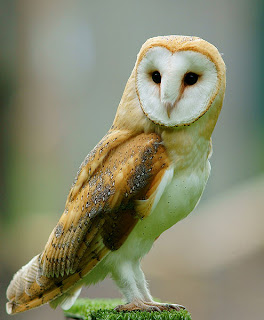 This barn owl was photographed in Surrey, England by Peter Trimming; the photo is available in Wikimedia Commons.
This barn owl was photographed in Surrey, England by Peter Trimming; the photo is available in Wikimedia Commons.I have seen only one owl in the wild, and it wasn't a barn owl, AKA screech owl. I have heard them, and they make quite unearthly shrieks, not at all like the gentle "Hoo" sound of other owls. Therefore, I took great pleasure in reading and viewing Barn Owl by David Chandler, with its many pictures taken by Nigel Blake.
The book is a small volume (127 pages, including index), though the pages are largeish (18.5x24.5 cm), and half the space is photos, which places it in a genre I call "small coffee-table". It is thus a quick read, but very informative. Each chapter covers a different phase of owl life or natural history.
The most significant thing I didn't know before was that over half the area that harbors barn owls, there is a single species, Tyto alba (shown above in its whitest phase). This species is the only one in North America and most of Europe, but more than a dozen other species populate areas throughout the rest of the world. Some species are locally called grass owls for their habit of nesting on the ground in tall grass. T. alba nests in cavities, usually rather high off the ground, 2-3 meters or higher. Nooks in barns and other outbuildings are thus ideal, thus leading to the common name.
All owls are predators, and barn owls are perhaps the most efficient. A pair with growing young might take 30-100 small mammals daily! That's a lot of field mice, voles, and shrews (and some rats) that would overrun us if not for owls. One owl can hunt down about ten times as many mice as the hungriest house cat.
Barn owls cough up bone-and-hair-laden pellets, as many other owls do, which makes it rather simple to determine their eating habits. Interestingly, it has been said that, if the owl's hunting range is marshy, it may take a lot of frogs, and a pellet of frog remains looks more like a golf ball than like the cigar-shaped pellet formed of small mammal remains.
Quick as the read was, it was a great pleasure to read this book, and an even greater pleasure just looking through the pictures. It appears to be pitched to ages from late middle school through high school.



No comments:
Post a Comment